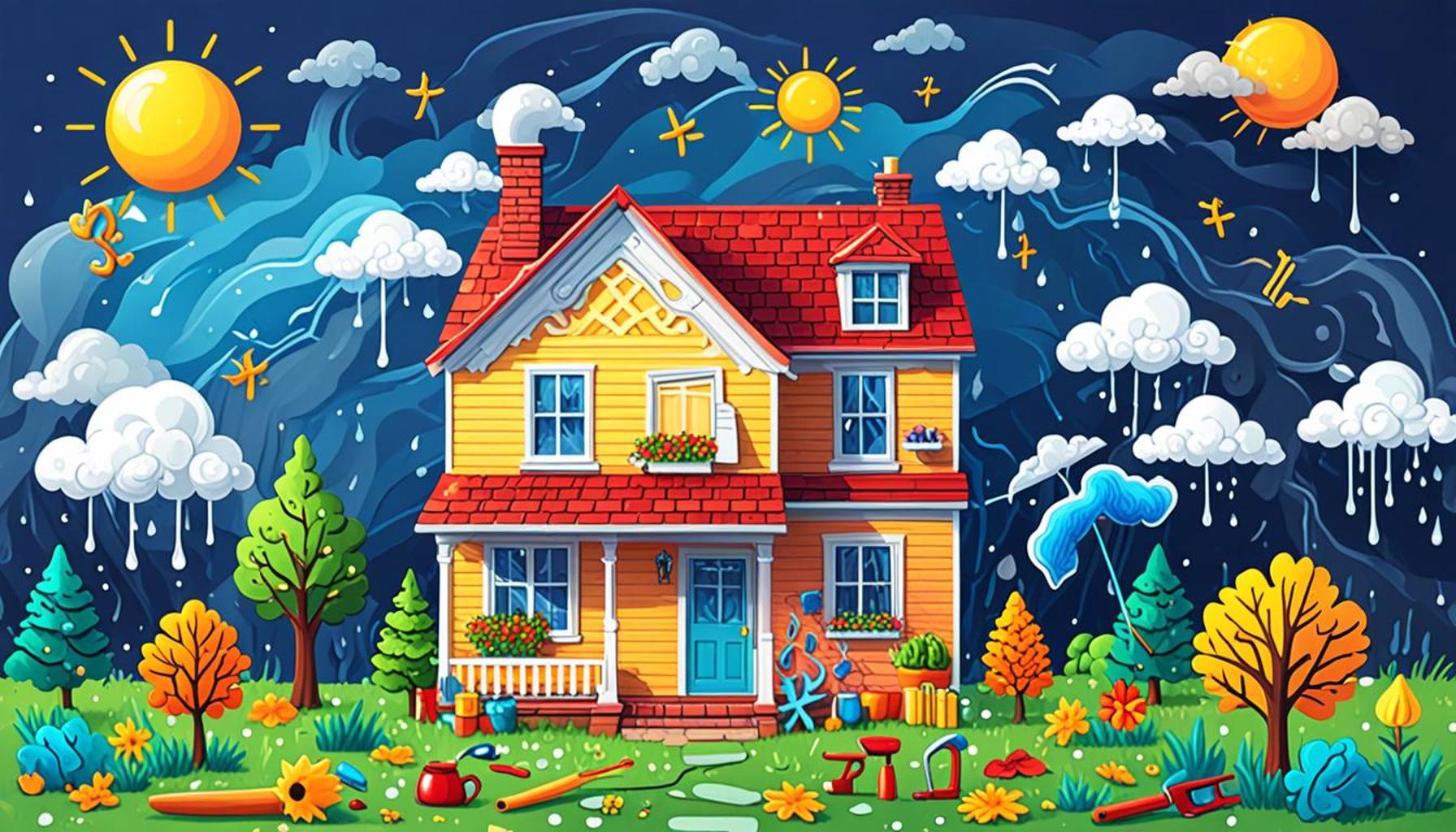How Weather Patterns Affect Your Home Maintenance Schedule Throughout the Year

The Essential Role of Weather in Home Maintenance Practices
As seasons shift, so do the intricate demands of home upkeep. Each weather pattern introduces unique challenges that require homeowners to remain vigilant and proactive regarding their maintenance schedule. Understanding how different aspects of weather interact with your residence is key to preserving its integrity and enhancing your living experience.
Several factors influence how you should approach your home care routine, including:
- Temperature Extremes: Regions that experience sweltering summers or frigid winters often see increased wear and tear. For instance, high temperatures can lead to roof damage or foundation settling, while freezing conditions can cause pipes to burst. Regularly checking insulation, the integrity of roofing, and plumbing systems is crucial, particularly before the onset of extreme weather.
- Seasonal Precipitation: Whether it’s the torrential downpours typical in the Pacific Northwest, heavy snowfalls in the Northeast, or droughts in the Southwest, precipitation impacts home care dramatically. Appropriate gutter maintenance and ensuring proper drainage can prevent water damage to your foundation, while snow removal from roofs is vital to prevent collapse under excessive weight.
- Local Climate: The microclimates across the United States can lead to vastly different home care concerns. Humid areas, like Florida, are breeding grounds for mold, necessitating the installation of dehumidifiers and regular inspections of roofs and basements. Conversely, arid regions might experience significant soil shrinkage, putting stress on the foundation.
Homeowners frequently underestimate the extent to which weather affects the durability and lifetime of their properties. A well-planned maintenance schedule that takes these yearly cycles into account can stave off costly repairs while significantly enhancing the comfort of your home.
By aligning your maintenance tasks with seasonal weather patterns, you not only ensure your house remains in peak condition but also amplify its energy efficiency and aesthetic appeal. For example, during the fall, consider cleaning gutters and trimming trees as preventative measures against winter storms, which can also minimize heating costs by improving insulation.
This article will delve deeper into essential home maintenance strategies tailored to various weather conditions. From preparing your home for the harsh realities of winter to ensuring optimal care during sweltering summer months, stay informed and ready to take on seasonal challenges with confidence and foresight.

DISCOVER MORE: Click here for safer cleaning choices
Planning Your Home Maintenance Around Seasonal Changes
Understanding the rhythm of the seasons is fundamental to developing an effective home maintenance schedule. Each time of year brings distinct weather patterns that can influence various components of your home. By aligning your maintenance tasks with these seasonal patterns, you can significantly reduce the risk of damage, enhance efficiency, and ensure that your home remains a safe haven.
Winter Preparations: Battling the Cold
As the chill of winter sets in, it’s imperative to prepare your home for the harsh realities of freezing temperatures and potential snow falls. Regularly inspecting your heating system is critical; as a homeowner, ensure that furnaces are serviced and filters are changed to avoid unexpected failures during the cold months. Furthermore, check for any drafts in windows and doors. Sturdily sealing these gaps not only keeps the cold air outside but also improves energy efficiency, leading to lower heating bills.
Additionally, homeowners in areas susceptible to heavy snowfall should ensure roof integrity is intact. A simple inspection can reveal weak spots that might not hold up under the weight of snow. During the winter months, make routine snow removal from roofs, especially if equipped with asphalt shingles, to prevent potential leaks or roof collapse.
Spring Awakening: Addressing the Aftermath
As winter fades into spring, focus shifts to recovery and rejuvenation. Spring typically brings rain, making it crucial to inspect your gutters and downspouts. Ensure they’re clear of debris to facilitate proper drainage and prevent water from pooling around your foundation. This upkeep can help stave off severe water damage that often goes unnoticed until significant problems arise.
This is also an ideal time to assess your landscape. Trees that might have been damaged by winter storms can pose a risk of falling on your home or power lines. Regularly trimming branches and removing dead wood not only enhances your yard’s aesthetic but also protects your property from potential hazards.
Summer Spotlight: Keeping Cool
When summer temperatures reach their peak, additional attention should be paid to your air conditioning systems. Regular maintenance of air conditioners, including cleaning coils and checking refrigerant levels, can drastically improve performance and prolong the lifespan of the unit. Homeowners should also be diligent in checking the exterior for damage when the mercury rises. This involves inspecting siding, decks, and patios for signs of wear or decay due to the intense sun exposure.
The summer months are perfect for outdoor projects as they allow for the application of weather-resistant paint and sealants. Applying these protective layers can prevent further deterioration from both sun and moisture, ensuring long-lasting beauty and durability.
In summary, by being proactive and carefully planning your home maintenance schedule according to the weather changes, you can extend the life of your residence while maintaining its comfort and value. Each season offers unique opportunities and challenges, and by following these guidelines, you can capitalize on the favorable months to ready your home for whatever Mother Nature sends your way.
| Seasonal Weather Impacts | Maintenance Considerations |
|---|---|
| Heavy Rainfall | Basement waterproofing and regular gutter cleaning to prevent water damage. |
| Cold Winters | Insulation checks to conserve heat and inspect heating systems for efficiency. |
| Storms | Assess roof integrity to avoid leaks and damage following strong winds. |
| Summer Heat | Air conditioning maintenance is crucial to ensure a cool environment as temperatures rise. |
Understanding seasonal changes in weather patterns can profoundly influence your home maintenance schedule. For example, during periods of heavy rainfall, ensuring that gutters are clear is essential to prevent water damage in your home. Additionally, as cold winters approach, performing insulation checks could save you substantial energy costs. With the increasing frequency of storms, assessing the integrity of your roof becomes a vital step to safeguard against leaks. Finally, as temperatures soar in summer, regular maintenance of your air conditioning systems ensures comfort and efficiency. Each weather change serves as a cue for homeowners to engage in vital maintenance activities that preserve their property and well-being throughout the year.
DISCOVER MORE: Click here to learn about innovative cleaning tools
Transitioning Through Seasons: Key Maintenance Tasks
As the cycle of seasons continues, it’s essential to adapt your home maintenance schedule to the changing weather patterns that each brings. Moving beyond summer into fall and winter calls for specific actions that not only enhance your home’s resilience but also safeguard it against the seasonal elements.
Fall Preparations: Winterizing Your Home
As the foliage begins to turn, fall maintenance becomes a priority. It’s the perfect time to prepare your home for the impending chill. Start by cleaning your gutters and downspouts once again. Fall leaves can clog these systems, leading to water backup and subsequent leaks in your roof and walls. To prevent costly repairs, clear out debris to ensure proper flow during rainy days.
Moreover, this is an ideal season for insulating your home. Check attic insulation and sealing around windows and doors to combat cold drafts. Adding weather stripping and caulking can provide an excellent barrier to keep your home warm and reduce heating costs. According to the U.S. Department of Energy, insulating your home can save around 15% on heating and cooling costs annually.
Additionally, inspect your exterior paint and siding. Fall temperatures provide a mild climate for any necessary repainting or repairs, which can help protect against moisture infiltration during winter. It’s a proactive measure that extends the life of your exteriors and helps maintain the overall appearance of your home.
Winter Maintenance: Focusing on Safety
Once winter descends, prioritize your family’s safety. Regularly check the property paths for ice and snow accumulation to reduce slip hazards. Outdoor lighting should be adequate to illuminate walkways, ensuring visibility during the darker months. Consider installing motion-sensing floodlights for added security and safety.
Indoor maintenance should also not be overlooked during winter. This is an opportune moment to test smoke detectors and carbon monoxide alarms, as these systems are crucial for safety during colder months when heating systems are running frequently. The National Fire Protection Association advises checking these alarms at least once a month.
Year-Round Considerations: Anticipating Weather Extremes
Maintaining your home isn’t limited to a seasonal checklist; year-round vigilance is required, particularly as climate patterns shift. Recently, extreme weather events—such as unexpected heavy rains, hurricanes, and severe storms—have become more commonplace. Preparing your home for these events is critical.
- Storm Windows and Shutters: Invest in storm windows or shutters to protect against wind and flying debris.
- Waterproofing Basements: Implement waterproofing measures during milder weather to prepare for sudden heavy rains.
- Emergency Kits: Keep a well-stocked emergency kit that includes flashlights, batteries, first aid, and non-perishable food in case of power outages.
By understanding how different weather patterns throughout the year contribute to your home’s needs, you can build a comprehensive and effective maintenance schedule that minimizes risks and enhances longevity. With organized planning and proactive measures, your home can withstand whatever weather challenges may lie ahead.
DISCOVER MORE: Click here to learn about the benefits of indoor plants</a
Concluding Thoughts: Embracing the Elements in Home Care
Incorporating an understanding of how weather patterns affect your home maintenance schedule can be a game-changer for homeowners across the United States. By adapting to the unique demands of each season, you safeguard not only the structural integrity of your home but also enhance its energy efficiency and aesthetic appeal. Recognizing that seasonal transitions require distinct maintenance actions—from protecting your roof in the rainy season to preparing your home for freezing temperatures—allows you to address issues proactively rather than reactively.
The shift toward unpredictable weather events due to climate change necessitates a heightened awareness of home preparedness. Investing in improvements such as storm windows, insulation, and emergency kits can prove invaluable when severe weather strikes. Alongside these practical measures, understanding the timing for seasonal tasks, like cleaning gutters in the fall or inspecting heating systems in winter, will equip you to maintain a home that’s not only comfortable but resilient.
Ultimately, a well-planned home maintenance schedule based on weather patterns can save you significant time and money in the long run. By anticipating seasonal challenges and responding accordingly, you ensure that your home remains a safe and welcoming haven throughout the year. As you look ahead to the changing seasons, consider this your call to action—investing time in your home today means reaping the rewards of a secure and lasting investment for years to come.


